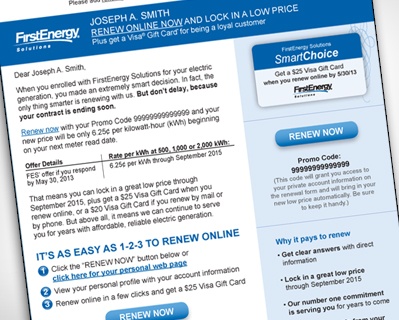

J&C Blog
Find all the latest marketing trends on the J&C Blog.

Find all the latest marketing trends on the J&C Blog.
Personalized email works. We recently ran a test of an email personalized with specific customer information versus a slightly more general email. Personalized information drove a 36% higher click-through rate than the general email.
This isn’t surprising, as we know today that consumers and business decision makers demand a greater level of personalization than ever before. According to MarketSherpa, 69% of people state that they would exchange their data for better, more personalized service.
For years, marketers have realized that segmentation drives relevancy. But now, people demand a higher level of personalization. They demand that communications be relevant at a segment level and that they include specifics about them, their interests and their behavior. According to MarketingSherpa, about half of marketers say they still need to improve their marketing database as well as build more sophistication and segmentation into their email programs.
So why do we believe personalization creates such a significant lift in performance? Utilizing personalization ensures that decision process becomes simpler and easier. Providing personalized information helps ensure a process can be completed simply and easily.

For example, Jacobs & Clevenger manages a program for Nokia Location & Commerce, the world leader in navigation system map technology. The program targets vehicle owners for map updates. Users need their vehicle information, including make, model and either Vehicle Identification Number (VIN) or navigation platform information. This presents a barrier for most vehicle owners to complete the process.
As I mentioned earlier, we recently did a test. The personalized version provided all the information necessary to complete the process: make, model, model year and VIN. Personalization also indicates the lapse in years since purchase, providing further awareness of the need for a map update. This is the type of email personalization that prospects and customers expect and appreciate. The personalized information did foster click-through as users didn’t have to track down information about their vehicle. It also provided brand credibility and validation that this email was from a trusted source, and specific to their current vehicle. This is a great example of how personalization can improve the user friendliness of a process and increase program results. In this example, personalization drove a 36% increase in response. This is a pretty astounding lift for inclusion of easy-to-execute variable information.
Creating personalized email requires discipline and application of best practices. Here are three other considerations to keep in mind to deliver effective and response-oriented personalized email.
1. Start with aggregate-level segmentation.
The starting point is to first consider segmentation designations. Tailoring content has always been a fundamental response marketing best practice. Customizing email for groups should leverage a combination of analytics and insights. The most common approach is to first determine similar segments based on analytics and then conduct research to better understand the insights of the groups. Typically, the insights will drive the email customization for those groups.
2. Leverage behavioral data to create personalization.
Rather than just sending out a blanket email that proclaims a “50% off sale,” promote products based on past buying behavior. Key buying behavior trigger points include purchase history, abandonment of page or shopping cart, and defecting or lapsing. Consider what you know about the target, then enhance the communications based on individual buying behavior. Email personalization based on buying behavior is one of the strongest forms of customization and it almost always generates a positive lift in response. Over the course of 36 months, we’ve been able to generate an 18% increase in transactions through targeting emails at key behavioral trigger points in a customer lifecycle.
3. Consider using personalized URLs.
 Tests show that personalized information, including personalized URLs (PURLs), empower and reinforce your email communications. Incorporating a PURL within the email creates a curiosity. The user wants to know what is on a page that is attached to their name or their business’s name. When using PURLs, it is critical to promote the personalized URL within the email. Delivering a personalized URL in email can create a significant lift in program response.
Tests show that personalized information, including personalized URLs (PURLs), empower and reinforce your email communications. Incorporating a PURL within the email creates a curiosity. The user wants to know what is on a page that is attached to their name or their business’s name. When using PURLs, it is critical to promote the personalized URL within the email. Delivering a personalized URL in email can create a significant lift in program response.
Topics: Email Marketing
303 E Wacker Drive, Suite 2030
Chicago, IL 60601
Phone: 312-894-3000
Fax: 312-894-3005